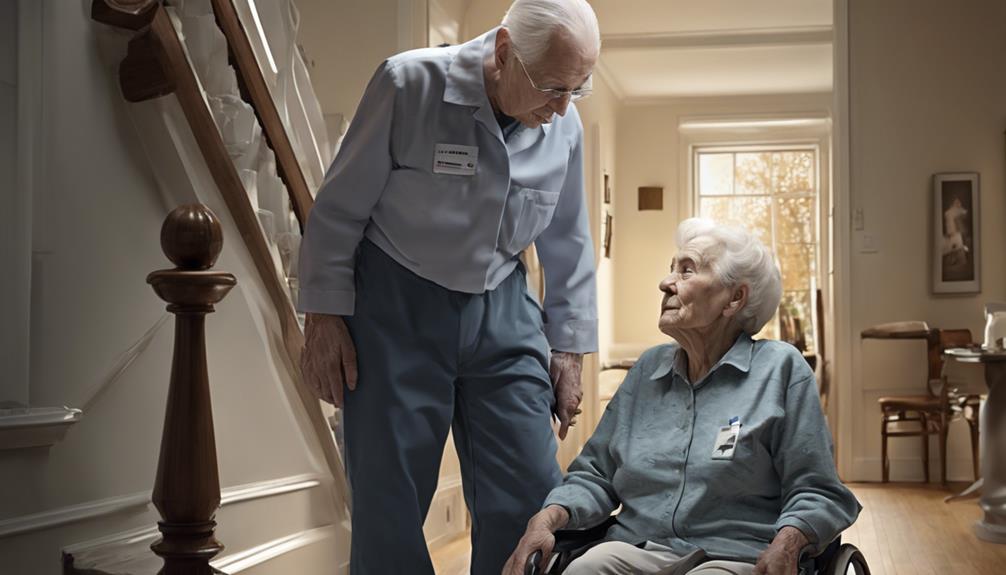Dealing with aggression in individuals with Alzheimer’s can present challenges and uncertainties. While safety is paramount, the key question is: how can we effectively manage these intense moments with patience and awareness?
Let's explore practical strategies and proactive approaches to diffuse aggression and promote a secure environment for all involved.
Key Takeaways
- Identify aggression triggers like fear and discomfort.
- Create a safe, calm environment to prevent harm.
- Use de-escalation techniques with clear communication.
- Seek professional help and prioritize caregiver self-care.
Understanding Alzheimer's Aggression Triggers
Understanding what triggers aggressive behavior in Alzheimer's patients is crucial for effectively managing their care and well-being.
Aggressive behavior in individuals with Alzheimer's can stem from a variety of sources, including fear, frustration, physical discomfort, and environmental factors. For example, dim lighting or loud noises may exacerbate feelings of confusion and agitation, leading to aggressive outbursts.
Additionally, approaching a person with Alzheimer's from behind can trigger a startle response, resulting in defensive behaviors. It's important to recognize that pain or discomfort, whether from an injury or an underlying medical condition, can also contribute to aggressive reactions in these individuals.
Establishing a Safe Environment

When caring for an Alzheimer's patient exhibiting violent behavior, ensuring a safe environment is paramount to the well-being of both the individual and those providing care. To establish a safe environment, follow these essential steps:
- Remove Potential Weapons: Take immediate action to eliminate any objects that could pose a danger to the patient or yourself. This simple step can prevent harm during episodes of aggression.
- Create a Calm Environment: Reduce noise, distractions, and triggers that may agitate the individual. A peaceful setting can help to reduce agitation and minimize the likelihood of aggressive outbursts.
- Maintain a Safe Distance: During moments of aggression, it's crucial to keep a safe distance from the patient to prevent physical harm. By staying at a distance, you can protect yourself while also allowing space for the individual to calm down.
De-escalation Techniques for Violent Episodes
To effectively manage violent episodes in Alzheimer's patients, employing de-escalation techniques is crucial for diffusing aggression and ensuring the safety of all involved. When faced with aggressive behavior, it's essential to use a calm and reassuring tone of voice to prevent escalating the situation further.
Maintaining a safe distance is important to protect both yourself and the individual during these episodes. Avoid sudden movements or gestures that could provoke or worsen the aggression. Offering simple, clear, and non-confrontational communication can help defuse the violent behavior, creating a more peaceful environment.
Utilize distraction techniques by redirecting the person's attention to a calming activity, which can effectively reduce aggression. Remember, protecting yourself is paramount, so approach the situation with care and empathy while prioritizing safety for everyone involved.
Seeking Professional Help and Support

After employing de-escalation techniques to manage violent episodes in Alzheimer's patients, seeking professional help and support is crucial for comprehensive care and tailored interventions. When managing aggressive behavior in someone with Alzheimer's, it's essential to involve experts who specialize in dementia care.
Here are key steps to consider:
- Consult with Healthcare Providers: Reach out to a healthcare provider or specialist experienced in managing agitation and aggression in individuals with Alzheimer's. They can provide valuable insights into treatment options and strategies to address challenging behaviors effectively.
- Seek Guidance from Specialists: Consider seeking guidance from a geriatric psychiatrist or behavioral neurologist. These professionals can offer personalized interventions and discuss medication options tailored to the individual's needs.
- Contact Support Groups: Connect with local Alzheimer's associations or support groups. These resources can provide practical advice, emotional support, and information on how to keep yourself safe while caring for a person exhibiting behavior changes.
Self-care Tips for Caregivers
Prioritizing your own physical and emotional well-being as a caregiver is essential for maintaining a healthy balance while caring for someone with Alzheimer's. It's crucial to recognize the signs of caregiver stress and take proactive steps to prevent burnout. Seeking support from family, friends, or joining caregiver support groups can provide invaluable assistance in navigating the challenges of caring for a loved one with Alzheimer's. Remember to take regular breaks and engage in activities that bring you joy and relaxation. Practice stress-relief techniques like deep breathing or meditation to help manage the emotional toll of caregiving. If you feel overwhelmed, don't hesitate to seek professional help. Here are some self-care tips for caregivers:
| Self-Care Tips | Description |
|---|---|
| Seek Support | Reach out to family, friends, or support groups for emotional assistance. |
| Take Regular Breaks | Schedule time for yourself to rest and recharge. |
| Practice Stress-Relief | Engage in activities like deep breathing or meditation to alleviate stress. |
| Recognize Signs of Stress | Be mindful of symptoms such as fatigue or irritability and address them promptly. |
| Consider Professional Help | Don't hesitate to seek professional assistance if you feel overwhelmed. |
Frequently Asked Questions
How Do You Deal With an Aggressive Alzheimer's Patient?
Dealing with an aggressive Alzheimer’s patient can be challenging. We must approach the situation with calmness and understanding. It is essential to prioritize the safety and comfort of both the patient and the caregiver. Utilizing calming techniques for Alzheimer’s patients, such as gentle music or familiar scents, can significantly alleviate anxiety and agitation. Moreover, maintaining a consistent routine and providing clear, simple communication can help create a sense of security that is often comforting for those affected by this challenging condition.
It's important to remove triggers, offer reassurance, and seek help if needed. Distraction techniques like engaging in different activities can also be helpful.
What Stage of Dementia Is Anger and Aggression?
When someone has dementia, anger and aggression can surface as the disease progresses. These behaviors are common in the middle to later stages of dementia. Individuals may become more agitated and violent as their cognitive functions decline.
Aggression can stem from frustration, confusion, fear, or difficulty communicating. Recognizing the stage of dementia-related aggression is crucial for caregivers to implement appropriate de-escalation strategies and ensure safety.
What Not to Do With Someone With Alzheimer's?
When supporting someone with Alzheimer's, we must remember what not to do.
It's crucial to avoid escalating the situation by raising our voice or arguing.
Instead, we should strive to remain calm and patient.
Additionally, physical restraint should only be used as a last resort for safety.
When Is It Time to Put an Alzheimer's Patient in a Home?
When an Alzheimer's patient's needs surpass what can be safely managed at home, it may be time to consider a care facility. Assessing the situation with compassion and in consultation with healthcare providers is crucial.
Ensuring the patient's safety and quality of life is paramount. Professional care may become necessary to address violent behavior or unmanageable aggression.
We recommend exploring residential care options to provide a secure environment and appropriate support.
Conclusion
As caregivers, we must remember that just like a storm, aggression in Alzheimer's patients will pass. By understanding triggers, creating a safe environment, and using de-escalation techniques, we can weather the storm together.
Seek help when needed, prioritize self-care, and remember that even in the darkest moments, there's always a glimmer of hope. Just as a rainbow appears after a storm, peace and calm can return after a violent episode.
Stay strong, caregivers, and remember you aren't alone.










